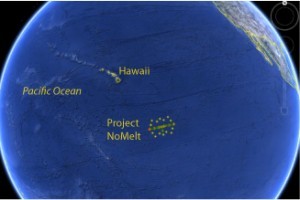After a four-day steam, we will arrive at our study area armed with a suite of geophysical tools to image the oceanic plate in this region with unprecedented precision and scope. We will toss 61 ocean-bottom seismographs (OBS) overboard in 5000-meter-deep water over a 600-km by 400 km area. OBS sink slowly to the seafloor and autonomously record sound waves from natural and man-made sources. Some of these sensors will remain on the bottom for over a year, recording the shaking from distant earthquakes. The remainder will record sound waves generated using large airguns towed in the water behind the ship and will be recovered at the end of this cruise. Simultaneously, we will record sound waves reflecting back from beneath the seafloor on an 6-km-long “streamer” containing hundreds of seismic sensors that we tow behind the ship. Finally, we will deploy a set of instruments designed to measure the electrical and magnetic fields at the seafloor. This combination of instruments will provide detailed information on the seismic wavespeed and electrical conductivity structure through the oceanic plate, which we will use to constrain the rock properties that control plate behavior. The experiment is funded by the U.S. National Science Foundation.
Seagoing research is an exciting but stressful business, and this cruise is no exception. In particular, the large water depths put tremendous pressure on seafloor instruments, increasing the risk of loss. In addition, the research activities are highly choreographed, and even modest difficulty with equipment or weather can compromise the experiment. But we are optimistic that this program will yield fundamental new insights on a core aspect of our paradigm for Earth processes. Over the next 30 days, I will provide regular updates on the project – both the day to day rhythms of life at sea, and the exciting science that will follow.

